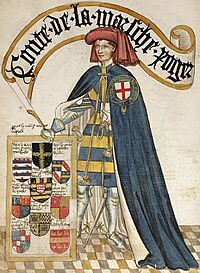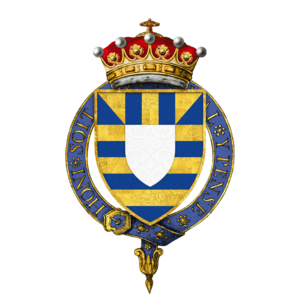Roger Mortimer, 2nd Earl of March facts for kids
Quick facts for kids
Roger Mortimer
|
|
|---|---|
| Earl of March Baron Mortimer of Wigmore |
|

Conte de la Marsche, Roger, illustration from the Bruges Garter Book, c.1450. He displays the arms of Mortimer on his tabard.
|
|
| Born | 11 November 1328 Ludlow Castle, Shropshire |
| Died | 26 February 1360 (aged 31) Rouvray |
| Buried | Wigmore Abbey |
| Noble family | Mortimer |
| Spouse(s) | Philippa Montagu |
| Issue | Roger Mortimer Edmund Mortimer, 3rd Earl of March Margery Mortimer Janet Mortimer Thomas Mortimer (illegitimate) |
| Father | Sir Edmund Mortimer |
| Mother | Elizabeth de Badlesmere |
Sir Roger de Mortimer, 2nd Earl of March (born November 11, 1328 – died February 26, 1360) was an important English nobleman. He was also a military leader during the Hundred Years' War. This was a long series of conflicts between England and France.
Roger was the son of Sir Edmund Mortimer. His mother was Elizabeth de Badlesmere. He was also the grandson of the first Earl of March.
Contents
A Young Nobleman's Journey
Getting His Family's Lands Back
The Mortimer family had lost their lands and titles. This happened after Roger's grandfather rebelled and was executed in 1330. Roger's father died the next year, leaving Roger with an uncertain future.
Roger slowly got his family's honors back. Around 1342, he got back the lands of Radnor. The next year, he received Wigmore, Herefordshire, his family's old home.
A Brave Knight in Battle
As a young man, Roger showed great courage in the wars in France. He fought bravely at the Battle of Crécy in 1347. This was a famous English victory.
After his military success, he received the rest of his family's lands. He was also one of the first knights to join the Order of the Garter. This was a very special group of knights. He was made a knight on July 12, 1346, by Edward the Black Prince.
Becoming an Earl
In 1354, the punishment against Roger's grandfather was removed. This meant his grandfather was no longer considered a traitor. The next year, Roger was officially called to Parliament as the Earl of March.
Important Jobs and Castles
In 1355, Roger got many important jobs. He became the Constable of Dover Castle. He also became the Warden of the Cinque Ports. These were important coastal towns. He went with King Edward III on a trip to France.
On October 19, 1356, Roger's grandmother, Joan de Geneville, passed away. Roger inherited her huge estates. This included Ludlow Castle, which became the main home for the Mortimer family.
In the years that followed, he joined the Royal Council. He was also put in charge of several castles. These included Montgomery, Bridgnorth, and Corfe.
In 1359 and 1360, he was a leader in King Edward III's invasion of France. He fought in the siege of Reims, which was not successful. However, he did capture Auxerre. The English army then moved into Burgundy. Roger died suddenly in Rouvray, France, during this campaign.
Family Life
His Wife and Children
Roger married Philippa de Montagu (1332–1381). She was the daughter of William Montagu, 1st Earl of Salisbury. Roger and Philippa had at least four children:
- Roger Mortimer, who died when he was young.
- Edmund Mortimer, 3rd Earl of March.
- Margery Mortimer.
- Janet Mortimer, who married Andrew Gray.
Roger also had at least one child outside of marriage:
- Sir Thomas Mortimer.
His Coat of Arms
A coat of arms is a special design that represents a family. Roger Mortimer's coat of arms was: Barry Or and azure, on a chief of the first three pallets between two gyronnies based on the second, over all an inescutcheon argent.


